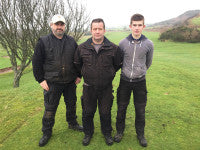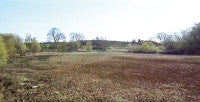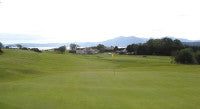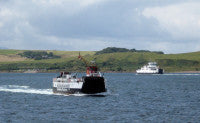Millport Golf Club - The Bell rings out...

It's smaller sister island - unsurprisingly Little Cumbrae (or Wee Cumbrae to give it its Scottish notation) - is technically uninhabited, although the ruins of a castle, a chapel and a still working lighthouse point to previous residents, and there is a caretaker looking after the Victorian pile of Little Cumbrae House on occasions. More illustrious island neighbours, such as Bute and Arran, can be clearly seen, whilst the coast of mainland Scotland appears to be but a stone's throw away.

The land on the island is primarily owned by the farmers, with the other major land owner being Millport Golf Club.

Following a change of ground leasing arrangements to lease directly from the Marquis of Bute, the club gathered momentum and a clubhouse was erected in 1892. In the same year, the local MP presented a silver cleek for an annual competition between the Cumbrae Club and the Rothesay Club on Bute, a match that continues to be keenly contested to this day.
In order to avoid confusion with Comrie Golf Club, the name of the club was changed to The Millport Golf Club in 1900, and a new clubhouse, which forms the basis of the present one, was built in 1909. The course, which had been originally designed by members of the club, was improved under the recommendations of James Braid and George Duncan in 1912 and 1913.

The original course was modernised in 1933, with the introduction of additional bunkers and contouring of the greens, at the same time becoming the 18-hole facility of today. The purchase of the golf course from the Bute Estate was completed in 1999.
It has been suggested that "Millport is an easy enough course from the yellow tees, if you catch it on a calm day and play reasonably well", but it's lofty position on the western side of the island means that it is often hit by winds in excess of 70mph coming in off the Atlantic. By contrast, the eastern side of the island is often a tranquil haven!

The course comes in at just short of 6,000 yards, has a par of 68 (ladies par is 72 with a yardage of 5,228) and demands a full repertoire of shot making. There are several blind shots to test golfers' skills. Out of bounds come into play on the first seven holes, just to add to the degree of difficulty and, at the 2nd, confronts the golfer both right and left!
There are no par 5 holes; the course, comprises fourteen par 4s - two measuring 449 yards - and four par 3s. In addition, there are three large practice areas.

Joe trained at Woodburn House, Langside College, before going on to hone his skills at Kilmacolm Golf Club, just south of Port Glasgow, under the watchful eye of then head greenkeeper Ronnie Bunting.
"The Millport course is built on clay," says Joe, "on land that the farmers couldn't use and, therefore, didn't want." It skirts around two reservoirs - lower and upper - that used to service the town.
"Drainage work is undertaken each winter to help alleviate the problems associated with the clay. This has taken the form of putting in ditches at strategic points, which not only helps to take the water away, but also enhances the hole. Other winter work includes the levelling of tees."

Joe says that, with so many visiting golfers, presentation is high on his list of priorities.
The course has a full irrigation system, with water being drawn from the Minniemoer, the larger of two small lochs at the northern end of the course close to the highest point on the island. At this juncture, it is worth making mention of the curling pond at Wee Minniemoer. This is an area where water is controlled via a sluice gate and allowed to freeze. It remains shallow for safety reasons and is the traditional way of creating the playing surface for curling. As recently as 2010, the Dumfries Cup was played on the pond and it was also made available for public use. It is currently drained, but remains a rare example of a traditional curling pond, complete with a bothy.

The current machinery list includes a Toro 6500 Reelmaster fairway mower, two Toro 3250 Greensmasters, a Lastec Articulator semi-rough mower, a John Deere pedestrian mower, a John Deere ProGator, a Kubota Grand L series tractor, a Kioti tractor and a utility vehicle. "It's pretty basic stuff," comments Joe, "and, if I had a wish list, it would simply be to have a fleet of new machinery."

Great Cumbrae is snake free, allegedly driven out by St. Mirin on his return from Ireland. "But there are plenty of rabbits," bemoans Joe. "It's like Watership Down here!"
The island is a haven for wildlife and polecats, owls and eagles can be seen regularly, as well as a large seabird population including fulmars, cormorants, oystercatchers and many more. Marine life includes seals, basking sharks, porbeagle sharks and dolphins.

Equally, I suspect, the isolated location and beautiful scenery in this sometimes overlooked corner of Ayrshire go a long way to helping make Joe's working life content. One thing is for sure though, there are far worse places to be working.
